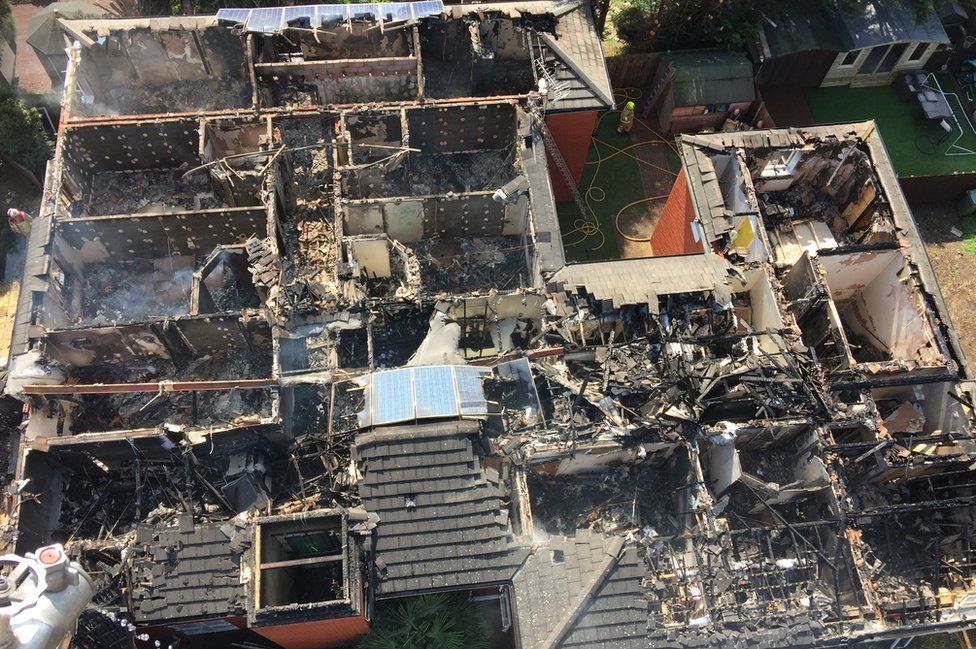In February this year an inquest opened into the circumstances that led to the deaths of two residents in a fire that broke out at a care home in April 2017. Some of the findings coming out of this tragic case could offer some important points for reflection for all managers and companies responsible for care home fire safety.
The blaze at Newgrange Care Home in Cheshunt, Hertfordshire was caused by an electrical fault in a wire. The fire quickly spread into the roof then through the care home. Initially, there had been confusion about the fire alarm system and the sound it was making. A buzzer had been triggered but staff were unsure what it meant. The fire alarm panel showed there was a fire in the linen room on the first floor; however, staff went to check the laundry room on the ground floor by mistake. Only later did they go up to check on the first floor by which time the fire had taken hold. The fire service was called, and it was only when the call operator told them to do so that staff began the evacuation. Thirty-five elderly residents lived in the home. Thirty-three were rescued by the fire service but tragically two residents, Ivy Spriggs and Daphne Holloway, died in the fire.
A genuine belief they had done enough
The company which ran the care home admitted to five charges of failing to comply with fire safety legislation and was fined £175,000 and had to pay prosecution costs. Reading that, it’s easy to jump to the immediate conclusion that the fire and its tragic outcomes were the consequences of a care home that wasn’t taking its responsibilities seriously.
But it was actually accepted by the judge that prior to this incident the company did have a good record in health and safety. It had put fire safety measures in place. And this is something that should make care home management teams pause for thought. Because they too might genuinely believe their care home fire safety measures are sufficiently robust. That was the case at Newgrange Care Home. Yet something went catastrophically wrong. And another point worthy of note is the fact that the judge observed the care home had begun to focus more on employee safety than resident safety. The approach to health and safety had started to drift away from where the main priorities should have been in a care home setting. To some extent it had lost its way in putting residents' needs first.
So what lessons can be learnt from this case?
- Review evacuation procedures
Clearly there was a failure to initiate the evacuation process quickly enough. A full evacuation should have begun way before the fire service arrived at the site. This might suggest a training need for staff but in this instance, they were actually following the care home’s procedure - which was effectively a ‘stay put’ policy where residents were told to wait in their rooms while staff left the premises to call the emergency services. This was not a policy consistent with well-established guidance on the safe evacuation of care homes. If staff had initiated the evacuation sooner, the emergency services would have had less people to get out of the building, increasing the likelihood that all residents could have been brought out safely.
In all care homes there must be an extremely carefully considered and person-centred plan for evacuation; at Newgrange Care Home thirty residents were not independently mobile and five were over a hundred years old. Plans should be reviewed often and practised regularly to ensure staff are able to initiate an evacuation immediately in an emergency.
- Consider the use of fire suppression
It was observed that the installation of fire suppression systems – in this instance sprinklers – could have been life-saving. Particularly where residents have mobility issues, it’s worth considering whether fitting sprinklers or other fire suppression systems could provide another layer of fire safety protection.
- Make sure staff understand the fire alarm system
Care home staff need to be able to recognise different warning alert sounds coming from fire detection equipment. And they must be familiar with the fire alarm panel and understand how to use the information it provides. This needs to happen as part of a broader programme of regular refresher training that keeps fire safety at the forefront of care home employees’ minds.
- Review building fire resilience
There were criticisms about the compartmentation of the care home – it was ineffective and fire curtains had been located in the wrong place leaving them unable to offer adequate protection.
In any building, compartmentation is an essential measure for reducing the spread of fire and smoke and protecting escape routes. This is important to bear in mind in the event of carrying out any renovation works or even something as relatively simple as running cables through a wall – make sure that any changes do not compromise any of the fire protection capability.
Contact us if you need help ensuring your care home is fire-safe
At a care home your whole fire risk assessment approach needs to go beyond what you see; take a person-centred approach and think through every possible scenario and plan for every worst-case eventuality to make sure you are as prepared as possible. And review it regularly to take the changing needs of residents into account.
If you feel you need support in making sure your fire prevention measures are as robust as possible, then please do not hesitate to get in contact with us.
